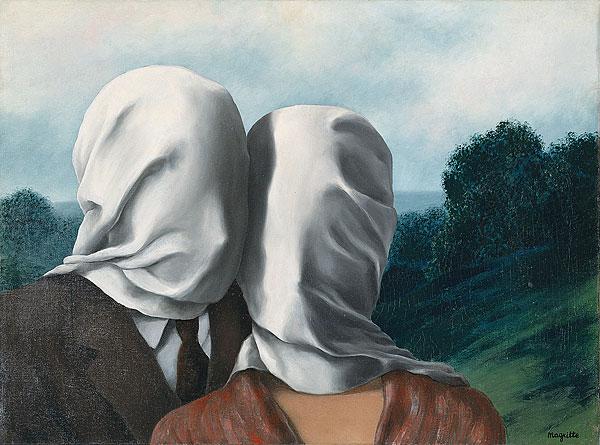René was born in Belgium and in 1922 he married Georgette Berger. In 1925, Magritte painted what he considered to be his first major work, in 1927, he held his first one-man show at the Galérie Le Centaure. He toyed with everyday objects, human habits and emotions, placing them in foreign contexts and questioning their familiar meanings. He rehabilitated the object. He made the commonplace profound and the rational irrational. His work goes beyond escapism and serves to reveal some of the murkier and complex aspects of the human condition.
|
|
 Viewer |
Les Amants, 1928 oil on canvas 54.0 (h) x 73.0 (w) cm signed l.r., oil "Magritte", not dated Purchased 1990 National Gallery of Australia, Sydney This is one of a small group of pictures painted by Magritte in Paris in 1927-28, in which the identity of the figures is mysteriously shrouded in white cloth. The group of paintings includes L'histoire centrale (The central story) 1927 (collection Isy Brachot, Brussels); L'invention de la vie( The invention of life) 1927-28 (private collection, Brussels); The lovers 1928 in the Australian National Gallery; and the similarly titled, similarly dated and similarly sized painting in the collection of Richard S. Zeisler, New York, in which the same shrouded heads of a man and a woman that appear in the Gallery's painting attempt to kiss each other through their grey cloth integuments. The origin of this disturbing image has been attributed to various sources in Magritte's imagination. Like many of his Surrealist associates, Magritte was fascinated by 'Fantômas', the shadowy hero of the thriller series which first appeared in novel form in 1913, and shortly after in films made by Louis Feuillade. The identity of 'Fantômas' is never revealed; he appears in the films disguised with a cloth or stocking over his head. Another source for the shrouded heads in Magritte's paintings has been suggested in the memory of his mother's apparent suicide. In 1912, when Magritte was only thirteen years of age, his mother was found drowned in the river Sambre; when her body was recovered from the river, her nightdress was supposedly wrapped around her head. Magritte himself disliked explanations which diffused the mystery of his images. His matter-of-fact style deliberately eschewed the assumption that these images were simply the expression of personal fantasy or private neurosis. They are images calculated to unlock the darker side of the mind. In The lovers, a man and a woman press their together in a fond gesture, almost as if they were having their photograph taken. It could be a holiday snapshot, with glimpses of the green verdure of the Normandy coast and the sea beyond. But through the simple device of the shrouds that cover the lovers' heads, tug back against their faces and curl like ropes across their shoulders, the spontaneous intimacy of this 'holiday snapshot' becomes a spectre of alienation, suffocation, even death. Outwardly so ordinary, even absurd, this image becomes chillingly real in the mind's eye. |
| Time Transfixed | Voice of Space | Human Condition | Lola de Valence | Lovers | Perspective | Personal Values | Son of Man |
| Renowned Artists Gallery index (61 galleries)
Other Parts of the Permanent Gallery | ||
| Digital Color Winners 2004 and 2005
Digital Color Winners 2002 and 2003 Digital Color Winners 1999, 2000 and 2001 |
Watercolor Painters
Oil Painters Pen and Pencil Artists |
Photographers
Sculptors Authors |